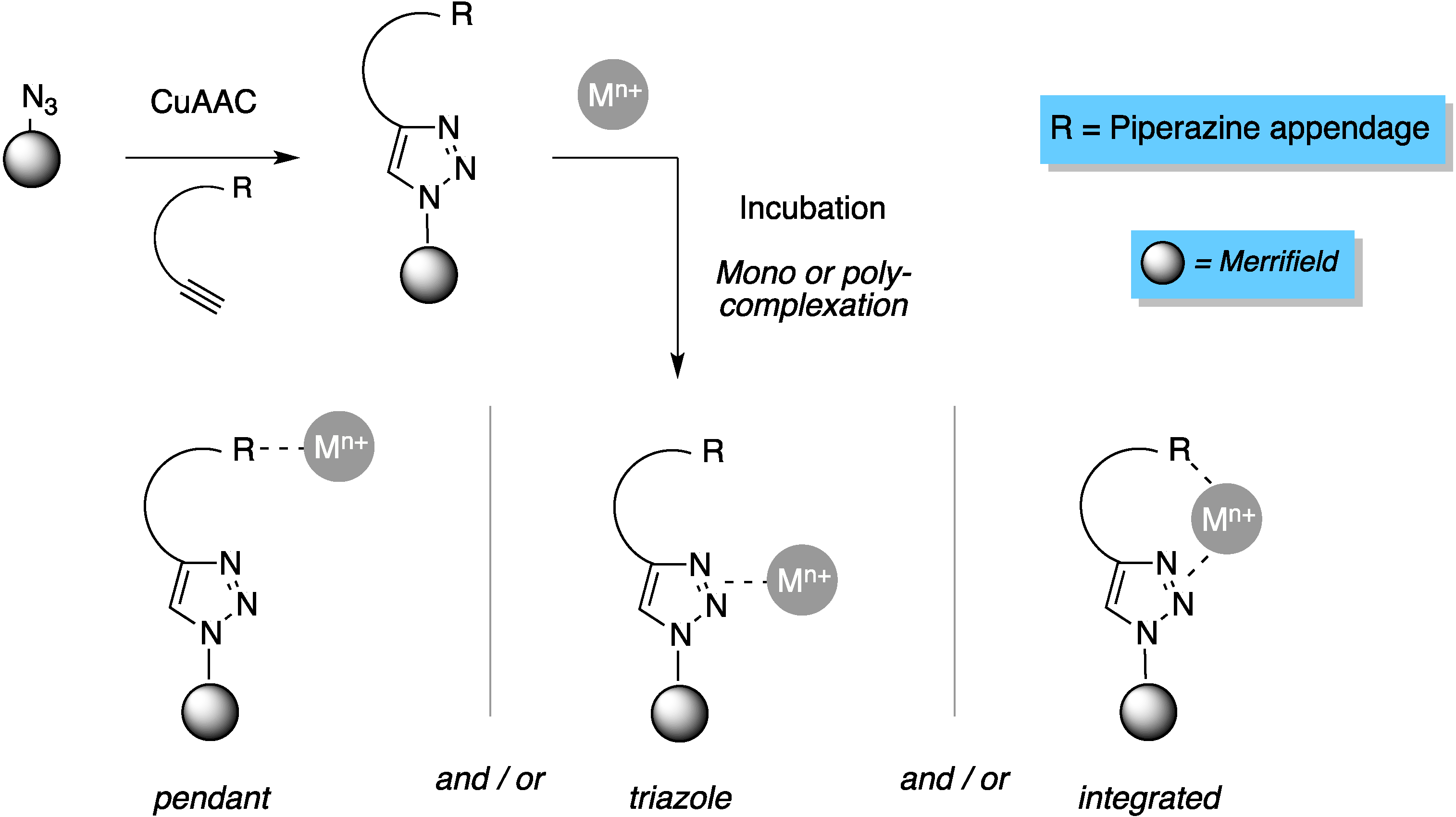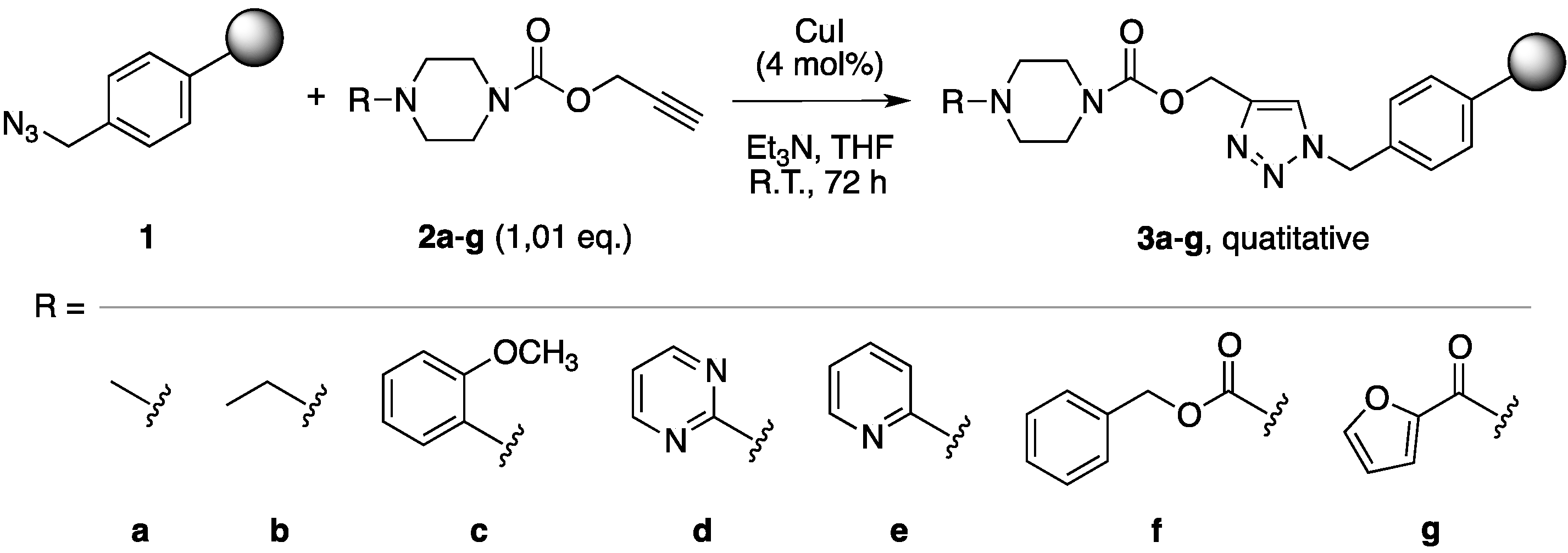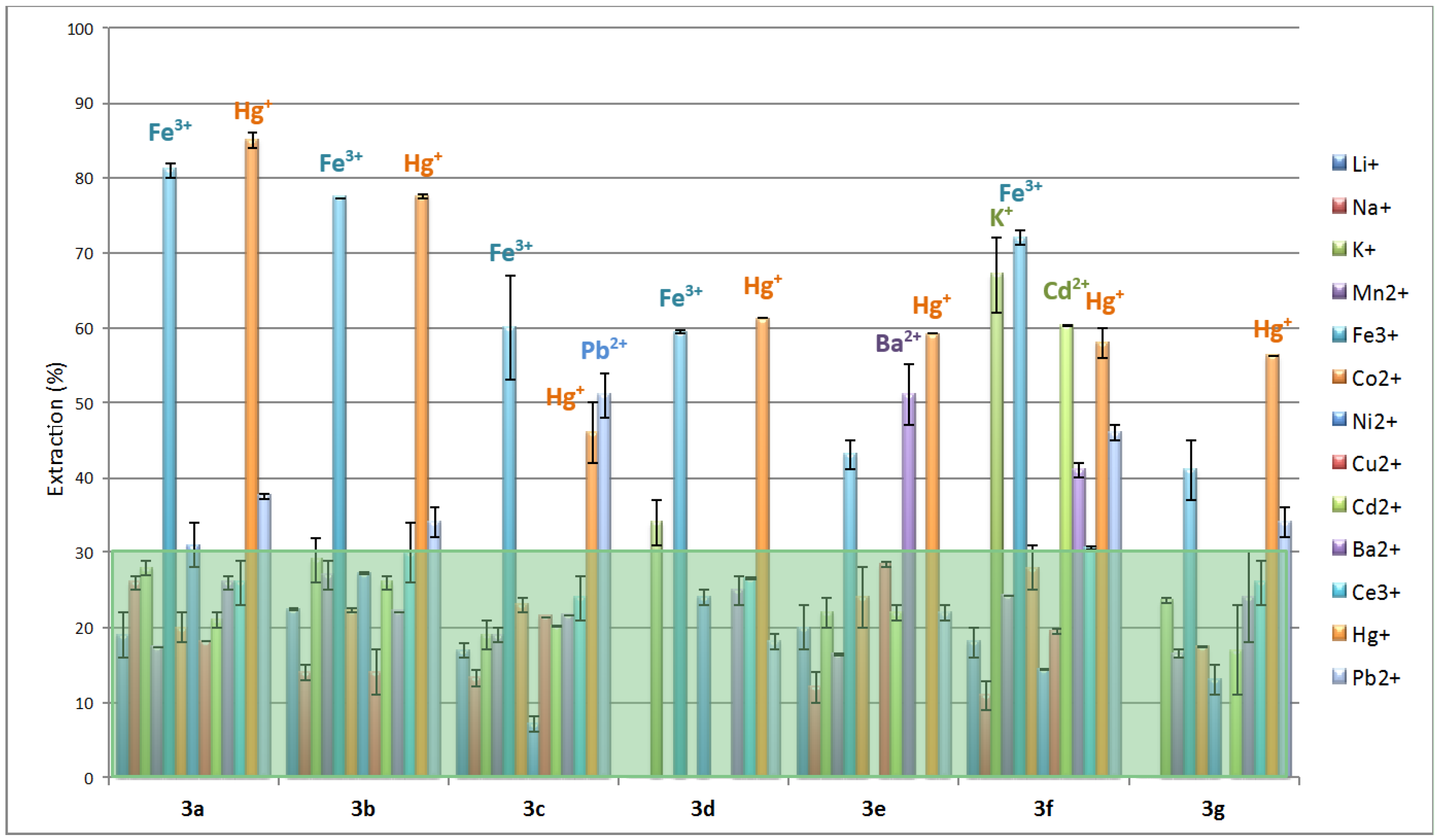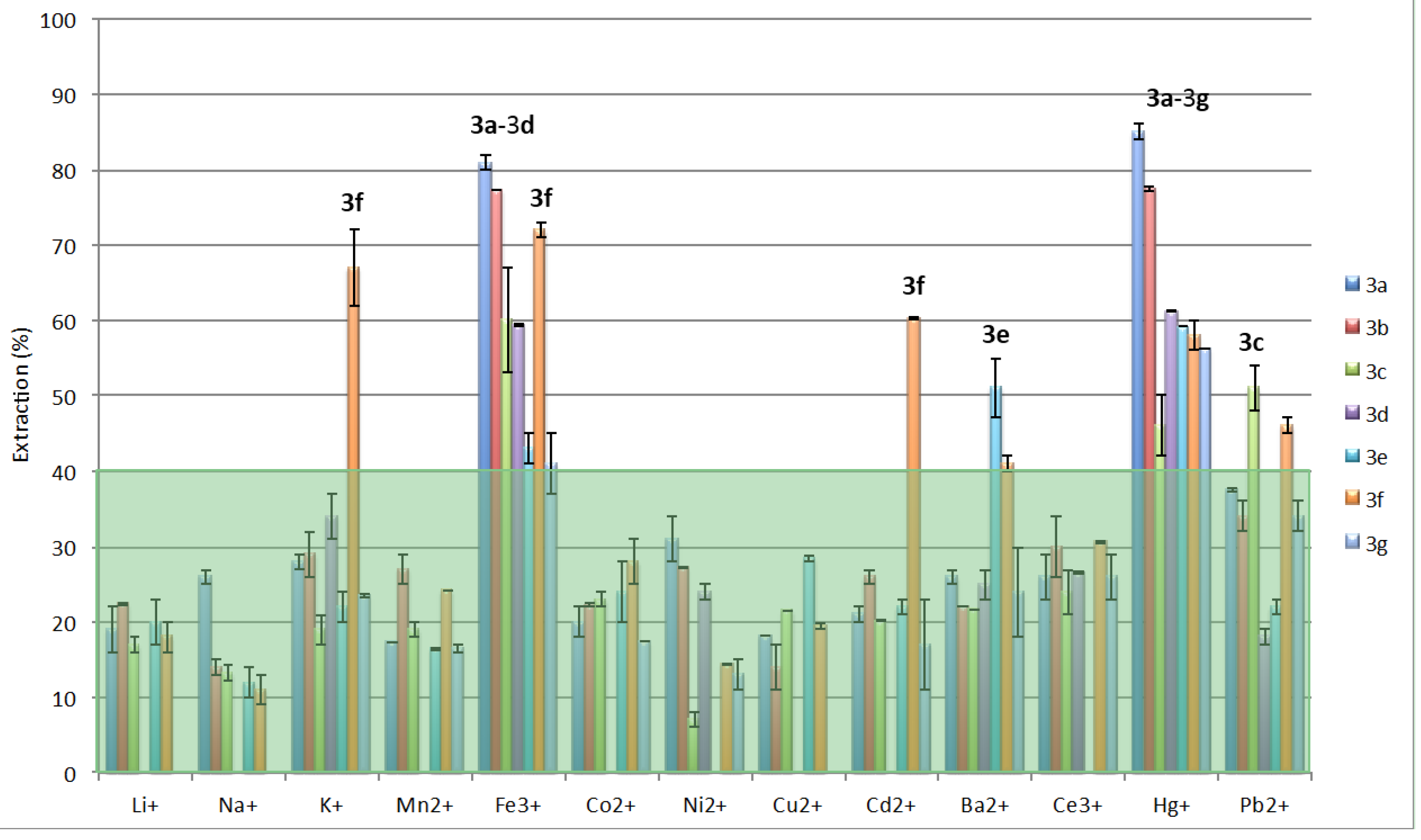“High-Throughput” Evaluation of Polymer-Supported Triazolic Appendages for Metallic Cations Extraction
Abstract
:1. Introduction

2. Experimental Section
2.1. N-Substituted Piperazine Propargylcarbamates and Polymers

2.1.1. General Procedure for the Synthesis of Propargylcarbamates Derivatives of Piperazines 2a–2g
2.1.2. General procedure for the Synthesis of Polymers 3a–3g
2.2. Conductimetric Quick Primary Evaluation of Metals Complexation
2.2.1. Extraction
2.2.2. Conductimetric Measurements

3. Results and Discussion
3.1. Polymers Preparation
3.2. Extraction Results
- In the case of Fe3+, as said before, all polymers are complexing this ion. The best results are 1.12 mg Fe3+ g−1 3a, 1.07 mg Fe3+ g−1 3b and 1.00 mg Fe3+ g−1 3f; followed by 0.83 mg Fe3+ g−1 3c and 0.82 mg Fe3+ g−1 3d, while 3e and 3g were borderline.
- Cd2+ and Ba2+ are more efficiently removed by 3f (3.37 mg Cd2+ g−1, 2.31 mg Ba2+ g−1) and 3e (2.87 mg Ba2+ g−1).
- For Hg+, as for Fe3+, all polymers can be used. In order, by sorption capacities, are 3a (6.49 mg Hg+ g−1), 3b (5.92 mg Hg+ g−1), 3d (4.68 mg Hg+ g−1), 3e (4.52 mg Hg+ g−1), 3f (4.43 mg Hg+ g−1), 3g (4.30 mg Hg+ g−1) and 3c (3.51 mg Hg+ g−1).
- Finally, in the case of Pb2+, polymers 3c (3.19 mg Pb2+ g−1) and 3f (2.88 mg Pb2+ g−1) are the more efficient.

4. Conclusions
Acknowledgments
Author Contributions
Conflicts of Interest
References
- Rifi, E.H.; Leroy, M.J.F.; Brunette, J.P.; Schloesser-Becker, C. Extraction of copper, cadmium and related metals with poly(sodium acrylate–acrylic acid) hydrogels. Solvent Extr. Ion Exch. 1994, 12, 1003–1119. [Google Scholar] [CrossRef]
- Hodgkin, J.H.; Eibi, R. Gold extraction with poly(diallylamine) resins. React. Polym. Ion Exch. Sorb. 1988, 9, 285–291. [Google Scholar] [CrossRef]
- Rivas, B.L.; Klahenhoff, D.; Perich, I.M. Kinetics of uranium sorption from acidic sulphate solutions onto crosslinked polyethyleneimine based resins. 10. Polym. Bull. 1990, 23, 219–223. [Google Scholar] [CrossRef]
- Anspach, W.M.; Marinsky, J.A. Complexing of nickel(II) and cobalt(II) by a polymethacrylic acid gel and its linear polyelectrolyte analog. J. Phys. Chem. 1975, 79, 433–439. [Google Scholar] [CrossRef]
- Nichide, H.; Oki, N.; Suchida, E.T. Complexation of poly(acrylic acid)s with uranyl ion. Eur. Polym. J. 1982, 18, 799–802. [Google Scholar] [CrossRef]
- Pollack, G.H. Water, energy and life: Fresh views from the water’s edge. Int. J. Des. Nat. Ecodyn. 2010, 5, 27–29. [Google Scholar] [CrossRef]
- Rifi, E.H.; Rastegar, F.; Brunette, J.P. Uptake of cesium, strontium and europium by a poly(sodium acrylate-acrylic acid) hydrogel. Talanta 1995, 42, 811–816. [Google Scholar] [CrossRef] [PubMed]
- Wang, X.; Weiss, R.A. A facile method for preparing sticky, hydrophobic polymer surfaces. Langmuir 2012, 28, 3298–3305. [Google Scholar] [CrossRef] [PubMed]
- Loret, J.F.; Brunette, J.P.; Leroy, J.F.M.; Candau, S.G.; Prevost, M. Liquid-lipophilic gel extraction of precious metals. Solv. Extr. Ion Exch. 1988, 6, 585–603. [Google Scholar] [CrossRef]
- Nghiem, L.D.; Mornane, P.; Potter, I.D.; Pereira, J.M.; Cattrall, R.W.; Kolev, S.D. Extraction and transport of metal ions and small organic compounds using polymer inclusion membranes (PIMs). J. Membr. Sci. 2006, 281, 7–41. [Google Scholar] [CrossRef]
- Peterson, J.; Nghiem, L.D. Selective extraction of cadmium by polymer inclusion membranes containing PVC and Aliquat 336: Role base polymer and extractant. Int. J. Environ. Technol. Manag. 2010, 12, 359–368. [Google Scholar] [CrossRef]
- Kebiche Senhadji, O.; Sahi, S.; Kahloul, N.; Tingry, S.; BenAmor, M.; Seta, P. Extraction du Cr(VI) par membrane polymère à inclusion. Sci. Technol. A 2008, 27, 43–50. [Google Scholar]
- Guibaud, G.; Baudu, M.; Dollet, P.; Condat, M.L.; Dagot, C. Role of extracellular polymers in cadmium adsorption by activated sludges. Environ. Technol. 1999, 20, 1045–1054. [Google Scholar] [CrossRef]
- Upitis, A.; Peterson, J.; Lukey, C.; Nghiem, L.D. Metallic ion extraction using polymer inclusion membranes (PIMs): optimising physical strength and extraction rate. Desalin. Water Treat. 2009, 6, 41–47. [Google Scholar] [CrossRef]
- Zotti, G.; Zecchin, S.; Schiavon, G.; Berlin, A.; Penso, M. Ionochromic and potentiometric properties of the novel polyconjugated polymer from anodic coupling of 5,5'-Bis(3,4-(ethylenedioxy)thien-2-Yl)-2,2'-Bipyridine. Chem. Mater. 1999, 11, 3342–3351. [Google Scholar] [CrossRef]
- Brembilla, A.; Cuny, J.; Roizard, D.; Lochon, P. Un nouveau polymère catalyseur bifonctionnel: Le polyvinyl-5 (6)benzimidazoleméthanethiol Synthèse et catalyse de l'hydrolyse de l'acétate de p-nitrophényle. Eur. Polym. J. 1983, 19, 729–735. [Google Scholar] [CrossRef]
- Rhazi, M.; Desbrières, J.; Tolaimate, A.; Rinaudo, M.; Vottero, P.; Alagui, A.; El Meray, M. Influence of the nature of the metal ions on the complexation with chitosan: Application to the treatment of liquid waste. Eur. Polym. J. 2002, 38, 1523–1530. [Google Scholar] [CrossRef]
- Kozlowski, C.; Walkowiak, W. Applicability of liquid membranes in chromium(VI) transport with amines as ion carriers. J. Membr. Sci. 2005, 266, 143–150. [Google Scholar] [CrossRef]
- Kozlowski, C.; Apostoluk, W.; Walkowiak, W.; Kita, A. Removal of Cr(VI), Zn(II) and Cd(II) ions by transport across polymer inclusion membranes with basic ion carriers. Physicochem. Probl. Min. Process. 2002, 36, 115–122. [Google Scholar]
- Toy, P.H.; Janda, K.D. Soluble polymer-supported organic synthesis. Acc. Chem. Res. 2000, 33, 546–554. [Google Scholar] [CrossRef] [PubMed]
- Girard, C.; Önen, E.; Aufort, M.; Beauvière, S.; Samson, E.; Herscovici, J. Reusable polymer-supported catalyst for the [3+2] Huisgen cycloaddition in automation protocols. Org. Lett. 2006, 8, 1689–1692. [Google Scholar] [CrossRef] [PubMed]
- Jlalia, I.; Meganem, F.; Herscovici, J.; Girard, C. “Flash” solvent-free synthesis of triazoles using a supported catalyst. Molecules 2009, 14, 528–539. [Google Scholar] [CrossRef] [PubMed]
- Jlalia, I.; Beauvineau, C.; Beauvière, S.; Önen, E.; Aufort, M.; Beauvineau, A.; Khaba, E.; Herscovici, J.; Meganem, F.; Girard, C. Automated synthesis of a 96 product-sized library of triazole derivatives using a solid phase supported copper catalyst. Molecules 2010, 15, 3087–3120. [Google Scholar] [CrossRef] [PubMed]
- Li, C.; Finn, M.G. Click chemistry in materials synthesis. II. Acid-swellable crosslinked polymers made by copper-catalyzed azide–alkyne cycloaddition. J. Polym. Sci. Part A: Polym. Chem. 2006, 44, 5513–5518. [Google Scholar] [CrossRef]
- Tasdelen, M.A.; Yilmaz, G.; Iskin, B.; Yagci, Y. Photoinduced free radical promoted copper(I)-catalyzed click chemistry for macromolecular syntheses. Macromolecules 2011, 45, 56–61. [Google Scholar] [CrossRef]
- Liu, Y.; Díaz, D.D.; Accurso, A.A.; Sharpless, K.B.; Fokin, V.V.; Finn, M.G. Click chemistry in materials synthesis. III. Metal-adhesive polymers from Cu(I)-catalyzed azide–alkyne cycloaddition. J. Polym. Sci. Part A 2007, 45, 5182–5189. [Google Scholar] [CrossRef]
- Dag, A.; Durmaz, H.; Demir, E.; Hizal, G.; Tunca, U. Heterograft copolymers via double click reactions using one-pot technique. J. Polym. Sci. Part A: Polym. Chem. 2008, 46, 6969–6977. [Google Scholar] [CrossRef]
- Opsteen, J.A.; Brinkhuis, R.P.; Teeuwen, R.L.M.; Lowik, D.W.P.M.; van Hest, J.C.M. “Clickable” polymersomes. Chem. Commun. 2007, 3136–3138. [Google Scholar] [CrossRef]
- Riva, R.; Schmeits, S.; Jérôme, C.; Jérôme, R.; Lecomte, P. Combination of ring-opening polymerization and “click chemistry”: Toward functionalization and grafting of poly(ε-caprolactone). Macromolecules 2007, 40, 796–803. [Google Scholar] [CrossRef]
- Löber, S.; Rodriguez-Loaiza, P.; Gmeiner, P. Click linker: Efficient and high-yielding synthesis of a new family of SPOS resins by 1,3-dipolar cycloaddition. Org. Lett. 2003, 5, 1753–1755. [Google Scholar] [CrossRef] [PubMed]
- Iskin, B.; Yilmaz, G.; Yagci, Y. ABC type miktoarm star copolymers through combination of controlled polymerization techniques with thiol-ene and azide-alkyne click reactions. J. Polym. Sci. Part A: Polym. Chem. 2011, 49, 2417–2422. [Google Scholar] [CrossRef]
- Xue, X.; Zhu, J.; Zhang, Z.; Cheng, Z.; Tu, Y.; Zhu, X. Synthesis and characterization of azobenzene-functionalized poly(styrene)-b-poly(vinyl acetate) via the combination of RAFT and “click” chemistry. Polymer 2010, 51, 3083–3090. [Google Scholar] [CrossRef]
- Shin, J.-A.; Lim, Y.-G.; Lee, K.-H. Synthesis of polymers including both triazole and tetrazole by click reaction. Bull. Korean Chem. Soc. 2011, 32, 547–552. [Google Scholar] [CrossRef]
- Struthers, H.; Mindt, T.L.; Schibli, R. Metal chelating systems synthesized using the copper(I) catalyzed azide-alkyne cycloaddition. Dalton Trans. 2010, 39, 675–696. [Google Scholar] [CrossRef] [PubMed]
- Urankar, D.; Pinter, B.; Pevec, A.; De Proft, F.; Turel, I.; Košmrlj, J. Click-triazole N2 coordination to transition-metal ions is assisted by a pendant pyridine substituent. Inorg. Chem. 2010, 49, 4820–4829. [Google Scholar] [CrossRef]
- Slimi, R.; Ben Othman, R.; Sleimi, N.; Ouerghui, A.; Girard, C. Polystyrene-supported triazolic substituted piperazines for metal ions extraction. React. Funct. Polym. 2015. submitted. [Google Scholar]
- Arseniyadis, S.; Wagner, A.; Mioskowski, C. A straightforward preparation of amino-polystyrene resin from Merrifield resin. Tetrahedron Lett. 2002, 43, 9717–9719. [Google Scholar] [CrossRef]
- Ouerghui, A.; Elamari, H.; Ghammouri, S.; Slimi, R.; Meganem, F.; Girard, C. Polystyrene-supported triazoles for metal ions extraction: Synthesis and evaluation. React. Funct. Polym. 2014, 74, 37–45. [Google Scholar] [CrossRef]
© 2015 by the authors; licensee MDPI, Basel, Switzerland. This article is an open access article distributed under the terms and conditions of the Creative Commons Attribution license (http://creativecommons.org/licenses/by/4.0/).
Share and Cite
Slimi, R.; Girard, C. “High-Throughput” Evaluation of Polymer-Supported Triazolic Appendages for Metallic Cations Extraction. Metals 2015, 5, 418-427. https://doi.org/10.3390/met5010418
Slimi R, Girard C. “High-Throughput” Evaluation of Polymer-Supported Triazolic Appendages for Metallic Cations Extraction. Metals. 2015; 5(1):418-427. https://doi.org/10.3390/met5010418
Chicago/Turabian StyleSlimi, Riadh, and Christian Girard. 2015. "“High-Throughput” Evaluation of Polymer-Supported Triazolic Appendages for Metallic Cations Extraction" Metals 5, no. 1: 418-427. https://doi.org/10.3390/met5010418




